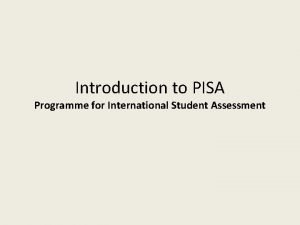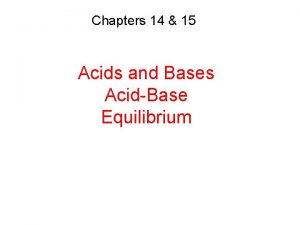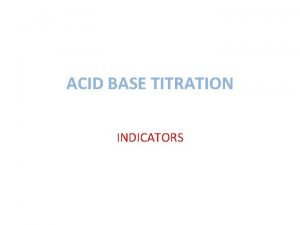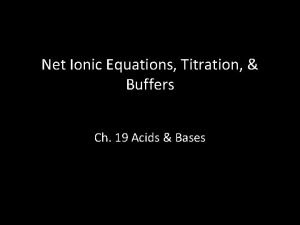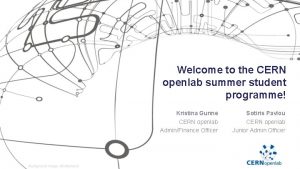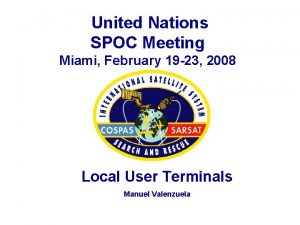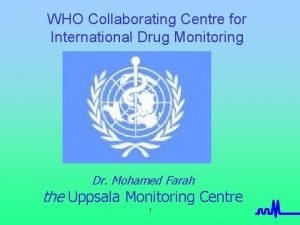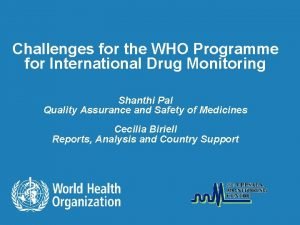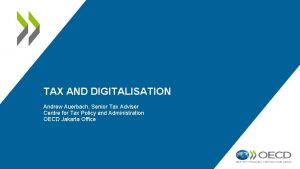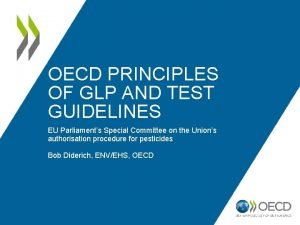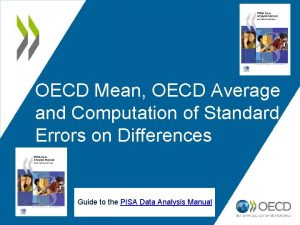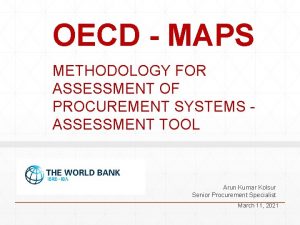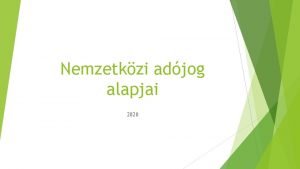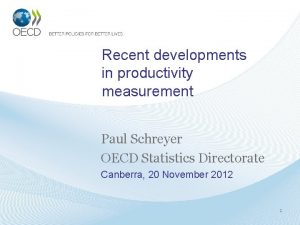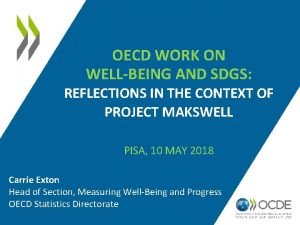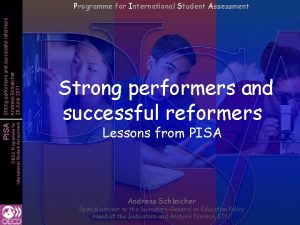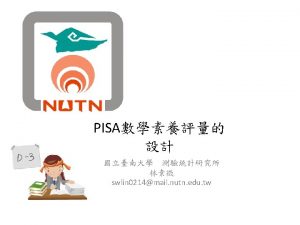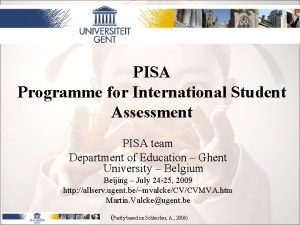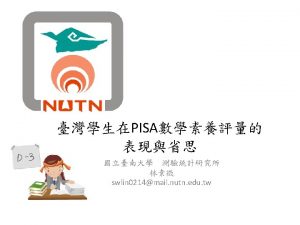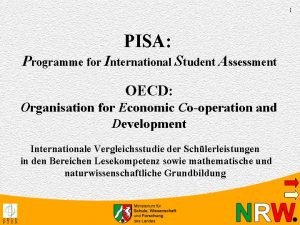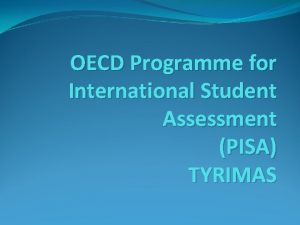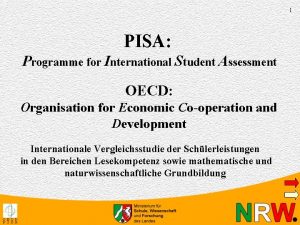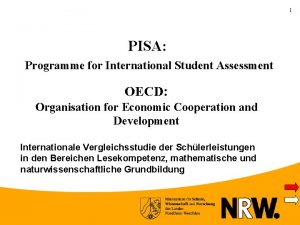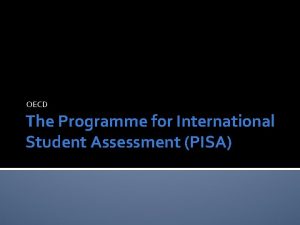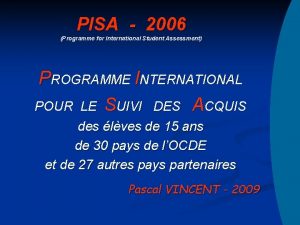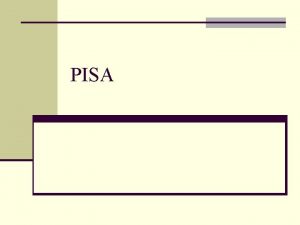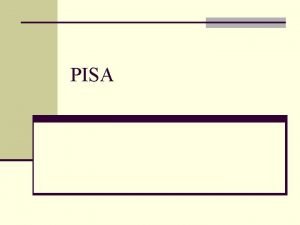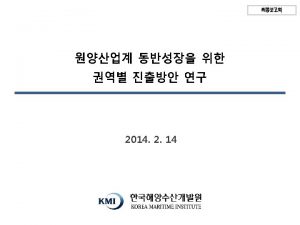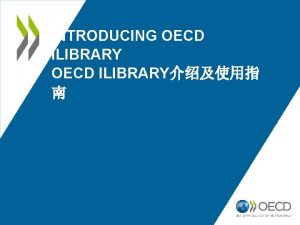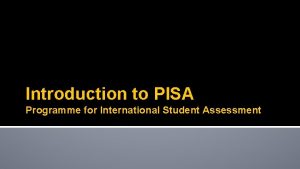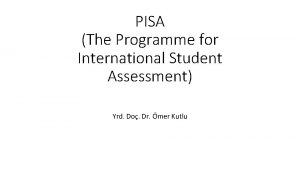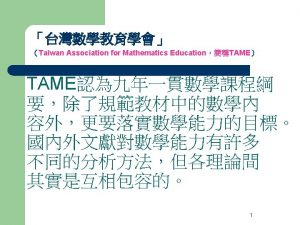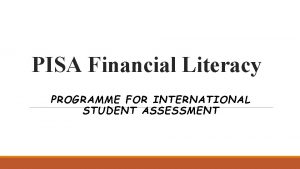OECD Programme for International Student Assessment PISA Strong
































- Slides: 32

OECD Programme for International Student Assessment PISA Strong performers and successful reformers Andreas Schleicher Austin, 30 July 2012 11 Programme for International Student Assessment Strong performers and successful reformers in education Lessons from global comparisons Austin, 30 July 2012 Andreas Schleicher Special advisor to the Secretary-General on Education Policy Head of the Indicators and Analysis Division, EDU

OECD Programme for International Student Assessment PISA Strong performers and successful reformers Andreas Schleicher 13 October 2011 22 The composition of the global talent pool has changed… Countries’ share in the population with tertiary education, for 25 -34 and 55 -64 yearold age groups, percentage (2009) 55 -64 -year-old population About 39 million people who attained tertiary level 25 -34 -year-old population About 81 million people who attained tertiary level

OECD Programme for International Student Assessment PISA Strong performers and successful reformers Andreas Schleicher 13 October 2011 33 The composition of the global talent pool has changed… Countries’ share in the population with tertiary education, for 25 -34 and 55 -64 yearold age groups, percentage (2009) Chart Title other, 14, 5 United States, 35, 8 other, 12, 9 Korea, 1, 6 Korea, 5, 7 Australia, 1, 7 Mexico, 1, 8 Italy, 1, 9 Spain, 2, 1 Brazil, 3, 5 Australia, 1, 6 Mexico, 3, 9 Japan, 10, 9 Italy, 2, 0 Spain, 3, 5 France, 3, 5 Brazil, 4, 5 Canada, 4, 2 United Kingdom, 5, 3 Germany, 6, 3 United States, 20, 5 Japan, 12, 4 China, 6, 9 France, 4, 1 Canada, 3, 1 United Kingdom, 4, 4 China, 18, 3 Germany, 3, 1

OECD Programme for International Student Assessment PISA Strong performers and successful reformers Andreas Schleicher 13 October 2011 44 Public cost and benefits for a man obtaining tertiary education (2007 or latest available year) Public benefits Public costs 193 584 168 649 United States Germany Belgium Hungary Slovenia Finland United Kingdom Netherlands Poland OECD Average Austria Portugal Korea Ireland Australia Italy Czech Republic Canada Japan France Norway New Zealand Sweden Spain Denmark Turkey 167 241 166 872 155 664 100 177 95 322 95 030 94 125 91 036 89 705 89 464 89 034 85 917 84 532 82 932 81 307 79 774 67 411 63 701 Net present 43, 419 value 46 482 37 542 29 582 28 621 21 724 0 50 000 100 000 150 000 200 000 250 000 In equivalent USD

How the demand for skills has changed Economy-wide measures of routine and non-routine task input (US) Mean task input as percentiles of the 1960 task distribution OECD Programme for International Student Assessment PISA Strong performers and successful reformers Andreas Schleicher 13 October 2011 55 65 Routine manual 60 Nonroutine manual 55 Routine cognitive 50 Nonroutine analytic 45 Nonroutine interactive 40 1960 1970 1980 The dilemma 1990 for education 2002 and training: The skills that are easiest to teach and test are also the ones that are easiest to digitise, (Levy and Murnane) automate and outsource

OECD Programme for International Student Assessment PISA Strong performers and successful reformers Andreas Schleicher Austin, 30 July 2012 66 PISA 2009 in brief PISA countries in 2001 2003 2000 2009 2006 1998 q Coverage world economy 83% Over half a million of students… 81% 77% 86% 85% 87% l representing 28 million 15 -year-olds in 74* countries/economies … took an internationally agreed 2 -hour test… Goes beyond testing whether students can reproduce what they were taught… … to assess students’ capacity to extrapolate from what they know and creatively apply their knowledge in novel situations l … and responded to questions on… l q their personal background, their schools and their engagement with learning and school Parents, principals and system leaders provided data on… l * school policies, practices, resources and institutional factors that help explain performance differences. Data for Costa Rica, Georgia, India, Malaysia, Malta, Mauritius, Venezuela and Vietnam will be published in December 2011

OECD Programme for International Student Assessment PISA Strong performers and successful reformers Andreas Schleicher Austin, 30 July 2012 99 What 15 -year-olds can do

Shanghai-China High reading performance Singapore New Zealand Japan Australia Belgium Poland, Switzerland United States Germany, Sweden France, Ireland Hungary, United Kingdom Suburban schools Urban schools OECD Programme for International Student Assessment PISA Strong performers and successful reformers Andreas Schleicher Austin, 30 July 2012 10 10 Macao-China Slovenia Slovak Czech Republic, Luxembourg, Israel Austria Dubai (UAE) Average performance of 15 -year-olds in 540, 000 Korea reading – extrapolate Finland Hong Kong-China and apply Canada 520, 000 Performance distribution in US 18% do not reach baseline Level 2 Netherlands Northeast (16% when excluding immigrants) Norway Midwest, Estonia Iceland (Finland 6%, Canada 9%) 500, 000 Liechtenstein Chinese Taipei Denmark. Economic cost: 72 trillion $ Portugal 10% are top performers Italy West Latvia Greece (Shanghai 20%) South 480, 000 Spain Croatia Lithuania Turkey 460, 000 Russian Federation Chile Serbia 55 45 440, 000 35 25 0 … 17 countries perform below this line Low reading performance

High reading performance OECD Programme for International Student Assessment PISA Strong performers and successful reformers Andreas Schleicher Austin, 30 July 2012 11 11 High average performance Large socio-economic disparities Average performance 15 -year-olds Highof average performancein science – extrapolate High social equity and apply Strong socioeconomic impact on student performance Socially equitable distribution of learning opportunities Low average performance Large socio-economic disparities High social equity Low reading performance

Australia High reading performance Belgium Canada High average performance Chile Czech Rep Large socio-economic disparities High social equity Denmark Finland Germany Greece Hungary Iceland Ireland Israel Strong socio. Socially equitable Italy economic impact on distribution of learning Japan student performance opportunities Korea Luxembourg Mexico Netherlands New Zealand Norway Poland Portugal Spain Low average performance Sweden Switzerland Large socio-economic disparities High social equity UK US Low reading performance OECD Programme for International Student Assessment PISA Strong performers and successful reformers Andreas Schleicher Austin, 30 July 2012 12 12 2009 Durchschnittliche Schülerleistungen im Bereich Mathematik

Australia High reading performance Belgium Canada High average performance Chile Czech Rep Large socio-economic disparities High social equity Denmark Finland Germany Greece Hungary Iceland Ireland Israel Strong socio. Socially equitable Italy economic impact on distribution of learning Japan student performance opportunities Korea Luxembourg Mexico Netherlands New Zealand Norway Poland Portugal Spain Low average performance Sweden Switzerland Large socio-economic disparities High social equity UK US Low reading performance OECD Programme for International Student Assessment PISA Strong performers and successful reformers Andreas Schleicher Austin, 30 July 2012 13 13 2009 Durchschnittliche Schülerleistungen im Bereich Mathematik

Poland United States Sweden Finland Mexico Ireland Iceland Norway Hungary Czech Republic Austria Italy Denmark Netherlands France Strong performers and successful reformers Andreas Schleicher Austin, 30 July 2012 Percentage points New Zealand United Kingdom Australia Japan Greece Germany Luxembourg Korea Belgium Switzerland Spain Portugal OECD Programme for International Student Assessment PISA 14 14 High performing systems often prioritize the quality of teachers over the size of classes Contribution of various factors to upper secondary teacher compensation costs per student as a percentage of GDP per capita (2004) Salary as % of GDP/capita Instruction time 1/teaching time 1/class size Difference with OECD average 15 10 5 0 -5 -10

Australia High reading performance Belgium Canada High average performance Chile Czech Rep Large socio-economic disparities High social equity Denmark Finland Germany Greece Hungary Iceland Ireland Israel Strong socio. Socially equitable Italy economic impact on distribution of learning Japan student performance opportunities Korea Luxembourg Mexico Netherlands New Zealand Norway Poland Portugal Spain Low average performance Sweden Switzerland Large socio-economic disparities High social equity UK US Low reading performance OECD Programme for International Student Assessment PISA Strong performers and successful reformers Andreas Schleicher Austin, 30 July 2012 15 15 2009 Durchschnittliche Schülerleistungen im Bereich Mathematik

Australia High reading performance Belgium Canada High average performance Chile Czech Rep Large socio-economic disparities High social equity Denmark Finland Germany Greece Hungary Iceland Ireland Israel Strong socio. Socially equitable Italy economic impact on distribution of learning Japan student performance opportunities Korea Luxembourg Mexico Netherlands New Zealand Norway Poland Portugal Spain Low average performance Sweden Switzerland Large socio-economic disparities High social equity UK US Low reading performance OECD Programme for International Student Assessment PISA Strong performers and successful reformers Andreas Schleicher Austin, 30 July 2012 16 16 2000 Durchschnittliche Schülerleistungen im Bereich Mathematik

Australia High reading performance Belgium Canada High average performance Chile Czech Rep Large socio-economic disparities High social equity Denmark Finland Germany Greece Hungary Iceland Ireland Israel Strong socio. Socially equitable Italy economic impact on distribution of learning Japan student performance opportunities Korea Luxembourg Mexico Netherlands New Zealand Other rapid improvers in reading: Norway Peru, Indonesia, Latvia, Israel and Brazil Poland Rapid improvers in mathematics: Portugal Mexico, Brazil, Turkey, Greece, Portugal, Italy and Spain Germany Low average performance Sweden Rapid improvers in science: Switzerland Large disparities High social equity Qatar, socio-economic Turkey, Portugal, Korea, Brazil, Colombia, UK Italy, Norway, United States, Poland US Low reading performance OECD Programme for International Student Assessment PISA Strong performers and successful reformers Andreas Schleicher Austin, 30 July 2012 17 17 2000 Durchschnittliche Schülerleistungen im Bereich Mathematik

OECD Programme for International Student Assessment PISA Strong performers and successful reformers Andreas Schleicher Austin, 30 July 2012 18 18 Changes in performance by type of task Increase percentage correct 10 9 OECD 8 Japan 7 6, 5 6 5 4 Japan 3 1, 7 2 1 0 0, 8 OECD Japan Multiple-choice - reproducing knowledge 1, 7 OECD Open-ended - constructing knowledge

School performance and socio-economic background United States Private school Public school in rural area Public school in urban area Student performance 643 OECD Programme for International Student Assessment PISA Strong performers and successful reformers Andreas Schleicher Austin, 30 July 2012 19 19 350 -2 Disadvantage -1 0 1 PISA Index of socio-economic background 2 Advantage

PISA 30 20 10 OECD Programme for International Student Assessment % 80 70 60 0 Shanghai-China Hong Kong-China Korea Macao-China Singapore Finland Japan Turkey Canada Portugal Chinese Taipei Poland New Zealand Spain Liechtenstein Estonia Netherlands Italy Switzerland Latvia Australia OECD average France Belgium Ireland Iceland Mexico United States Greece Thailand Croatia Tunisia Norway Hungary Sweden Slovenia Indonesia Denmark Chile United Kingdom Israel Colombia Germany Brazil Czech Republic Slovak Republic Luxembourg Lithuania Austria Russian Federation Trinidad and Tobago Uruguay Serbia Jordan Albania Argentina Dubai (UAE) Romania Bulgaria Panama Montenegro Kazakhstan Peru Azerbaijan Qatar Kyrgyzstan Strong performers and successful reformers Andreas Schleicher Austin, 30 July 2012 20 20 Percentage of resilient students among disadvantaged students Resilient student: Comes from the bottom quarter of the socially most disadvantaged students but performs among the top quarter of students internationally (after accounting for social background) 50 40 Less than 15% resilient students among disadvantaged students More than 30% resilient students among disadvantaged students Between 15%-30% of resilient students among disadvantaged students

OECD Programme for International Student Assessment PISA Strong performers and successful reformers Andreas Schleicher 13 October 2011 21 21 Policy Policies and practices R R System E School Equity Learning climate Discipline Teacher behaviour Parental pressure Teacher-student relationships Dealing with heterogeneity Grade repetition Prevalence of tracking Expulsions Ability grouping (all subjects) Standards /accountability Nat. examination

OECD Programme for International Student Assessment PISA Strong performers and successful reformers Andreas Schleicher Austin, 30 July 2012 22 22 What does it all mean?

OECD Programme for International Student Assessment PISA Strong performers and successful reformers Andreas Schleicher 13 October 2011 23 23 r to universal achievement A commitment to education and the belief that competencies can be learned and. Goals, therefore all children can achieve gateways, Coherence instructional systems Universal educational standards and personalisation as the approach to heterogeneity in the student body… … as opposed to a belief that students have different destinations to be met with different expectations, and selection/stratification as the approach to heterogeneity Capacity at l Clear articulation who is responsible for A learning point of system ensuring student success and to whom delivery l Lessons from PISA on successful education systems Resources where they yield most Incentives and accountability

OECD Programme for International Student Assessment PISA Strong performers and successful reformers Andreas Schleicher Austin, 30 July 2012 24 24 to universal achievement Clear ambitious goals that are shared across Goals, the system and aligned with high stakes gateways, Coherence instructional gateways and instructional systems r l Lessons from PISA on successful education systems l A learning system Well established delivery chain through which curricular goals translate into instructional systems, instructional practices and student learning (intended, implemented and achieved) High level of metacognitive content of instruction Capacity at point of delivery Resources where they yield most Incentives and accountability

to universal achievement OECD Programme for International Student Assessment PISA Strong performers and successful reformers Andreas Schleicher Austin, 30 July 2012 25 25 Goals, gateways, instructional systems Coherence r Capacity at the point of delivery l A learning system Attracting, developing and retaining high quality teachers and school leaders and a work organisation in which they can use their potential Capacity at point of Instructional leadership and human resource delivery management in schools Keeping teaching an attractive profession System-wide career development Lessons from PISA on successful education systems l l l Resources where they yield most Incentives and accountability FIN, Sahl, SIN

to universal achievement OECD Programme for International Student Assessment PISA Strong performers and successful reformers Andreas Schleicher Austin, 30 July 2012 26 26 r Goals, Incentives, accountability, knowledge management gateways, l Coherence Aligned incentive structures For students l l instructional systems How gateways affect the strength, direction, clarity and nature of the incentives operating on students at each stage of their education Degree to which students have incentives to take tough courses and study hard Opportunity costs for staying in school and performing well Lessons from PISA For teacherson successful Make innovations in pedagogy and/or organisation A learning systems their own performance system Improveeducation l l l l and the performance of their colleagues Pursue professional development opportunities that lead to stronger pedagogical practices Capacity at point of delivery A balance between vertical and lateral accountability Effective instruments to manage and share knowledge and spread innovation – communication. Incentives within the system and Resources where they and with stakeholders around it yield most accountability A capable centre with authority and legitimacy to act

School autonomy, accountability and student performance OECD Programme for International Student Assessment PISA Strong performers and successful reformers Andreas Schleicher Austin, 30 July 2012 27 27 Impact of school autonomy on performance in systems with and without accountability arrangements PISA score in reading 500 498 490 495 493 489 School autonomy in resource allocation Schools with more a 480 Systems with more accountability Systems with less accountability System’s accountability arrangements Schools with less autonomy

Strong performers and successful reformers Andreas Schleicher Austin, 30 July 2012 28 28 Public and private schools Observed performance difference Government schools Government dependent private Government independent private % OECD Programme for International Student Assessment PISA Australia Austria Canada Chile Czech Republic Denmark Estonia Finland Germany Greece Hungary Iceland Ireland Israel Italy Japan Korea Luxembourg Mexico Netherlands New Zealand Norway Poland Portugal Slovak Republic Slovenia Spain Sweden Switzerland Turkey United Kingdom United States Argentina Brazil Hong Kong-China Indonesia Jordan Russian Federation Shanghai-China Singapore Chinese Taipei 0 20 40 60 80 Difference after accounting for socio-economic background of students and schools -150 -100 -50 0 50 100 Score point difference Private schools perform better Public schools perform better

OECD Programme for International Student Assessment PISA Strong performers and successful reformers Andreas Schleicher Austin, 30 July 2012 29 29 Local responsibility and system-level prescription Trend in OECD countries System-level prescription ‘Tayloristic’ work organisation Schools today The industrial model, detailed prescription of what schools do Schools tomorrow? Building capacity Finland today Every school an effective school Schools leading reform Teachers as ‘knowledge workers’

to universal achievement OECD Programme for International Student Assessment PISA Strong performers and successful reformers Andreas Schleicher Austin, 30 July 2012 30 30 Coherence A learning system r Goals, gateways, instructional systems Lessons from PISA on successful education systems Investing resources where they can make most of a difference l l Alignment of resources with key challenges (e. g. attracting the most talented teachers to the most challenging classrooms) Resources Incentives where they andhigh Effective spending choices that prioritise yieldover mostsmaller classes accountability quality teachers Capacity at point of delivery CHN

to universal achievement Strong performers and successful reformers Andreas Schleicher Austin, 30 July 2012 31 31 Coherence A learning system OECD Programme for International Student Assessment PISA r Goals, gateways, instructional systems l l Lessons from PISA on successful education systems An outward orientation to keep the system learning, technology, international benchmarks as the ‘eyes’ and ‘ears’ of the system A learningchallenges and potential future Recognising system threats to current success, learning from them, designing responses and implementing these Resources where they yield most Capacity at point of delivery Incentives and accountability SIN

to universal achievement OECD Programme for International Student Assessment PISA Strong performers and successful reformers Andreas Schleicher Austin, 30 July 2012 32 32 r Coherence of policies and practices l l Alignment of policies across Coherence all aspects of the system Coherence of policies over sustained periods of time Consistency of implementation Fidelity of implementation (without excessive control) A learning system Goals, gateways, instructional systems Lessons from PISA on successful education systems Resources where they yield most Capacity at point of delivery Incentives and accountability CAN

OECD Programme for International Student Assessment PISA Strong performers and successful reformers Andreas Schleicher Austin, 30 July 2012 33 33 Education reform trajectories The old bureaucratic system Some students learn at high levels Student inclusion The modern enabling system All students need to learn at high levels Curriculum, instruction and assessment Routine cognitive skills, rote learning Learning to learn, complex ways of thinking, ways of working Teacher quality Few years more than secondary High-level professional knowledge workers Work organisation ‘Tayloristic’, hierarchical Flat, collegial Accountability Primarily to authorities Primarily to peers and stakeholders

OECD Programme for International Student Assessment PISA Strong performers and successful reformers Andreas Schleicher Austin, 30 July 2012 34 34 Find out more about PISA at… l OECD www. pisa. oecd. org – All national and international publications – The complete micro-level database l U. S. White House www. data. gov l Email: Andreas. Schleicher@OECD. org Thank you ! … and remember: Without data, you are just another person with an opinion
 What does pisa stand for
What does pisa stand for Be strong be strong be strong in the lord
Be strong be strong be strong in the lord Strong acid strong base titration
Strong acid strong base titration Weak acid strong base titration curve
Weak acid strong base titration curve How to remember strong acids and strong bases
How to remember strong acids and strong bases Weak base strong acid titration curve
Weak base strong acid titration curve Strong acid examples
Strong acid examples Net ionic equation for titration
Net ionic equation for titration Cern openlab summer student programme
Cern openlab summer student programme Geolut
Geolut International advocacy programme
International advocacy programme International advocacy programme
International advocacy programme Who programme for international drug monitoring
Who programme for international drug monitoring International advocacy programme
International advocacy programme Who programme for international drug monitoring
Who programme for international drug monitoring Creative arts grade 9 lesson plans term 3
Creative arts grade 9 lesson plans term 3 Ems business plan grade 9
Ems business plan grade 9 2020 revised curriculum and assessment plans
2020 revised curriculum and assessment plans 2020 revised curriculum and assessment plans grade 6
2020 revised curriculum and assessment plans grade 6 2020 revised curriculum and assessment plans
2020 revised curriculum and assessment plans Melinda brown oecd
Melinda brown oecd Oecd trade
Oecd trade Andrew auerbach
Andrew auerbach Oecd working group on bribery
Oecd working group on bribery Oecd trade facilitation indicators
Oecd trade facilitation indicators Andrew bell oecd
Andrew bell oecd Principles of glp
Principles of glp Oecd nations meaning
Oecd nations meaning Oecd maps
Oecd maps Oecd modellegyezmény magyarul
Oecd modellegyezmény magyarul Oecd scenarios for the future of schooling
Oecd scenarios for the future of schooling Paul schreyer oecd
Paul schreyer oecd Oecd wellbeing framework
Oecd wellbeing framework
